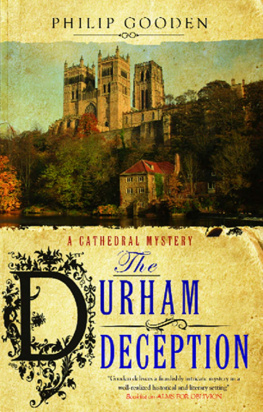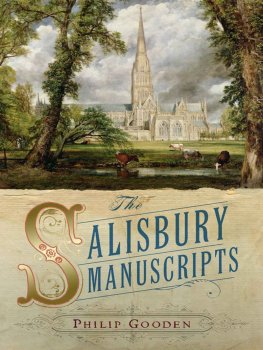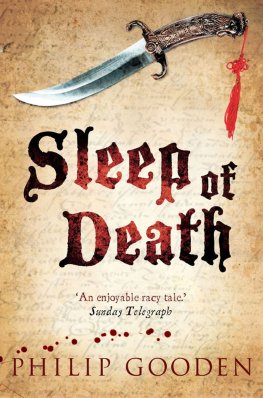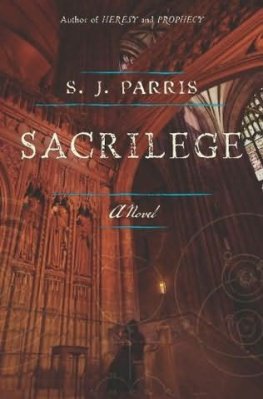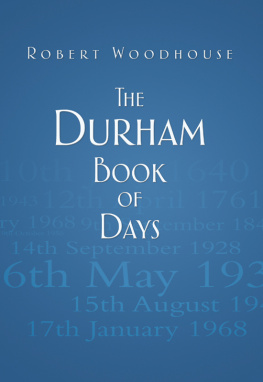Recent Titles from Philip Gooden
The Cathedral Murder Mysteries
THE SALISBURY MANUSCRIPT
THE DURHAM DECEPTION *
The Shakespearean Murder Mysteries
THAT SLEEP OF DEATH
DEATH OF KINGS
THE PALE COMPANION
ALMS FOR OBLIVION
MASK OF NIGHT
AN HONOURABLE MURDER
* available from Severn House
THE DURHAMDECEPTIONPhilip Gooden
This eBook is copyright material and must not be copied, reproduced, transferred, distributed, leased, licensed or publicly performed or used in any way except as specifically permitted in writing by the publishers, as allowed under the terms and conditions under which it was purchased or as strictly permitted by applicable copyright law. Any unauthorised distribution or use of this text may be a direct infringement of the authorss and publishers rights and those responsible may be liable in law accordingly.
This first world edition published 2011 in Great Britain and the USA by SEVERN HOUSE PUBLISHERS LTD of 915 High Street, Sutton, Surrey, England, SM1 1DF. Trade paperback edition first published in Great Britain and the USA 2011 by SEVERN HOUSE PUBLISHERS LTD.
Copyright 2011 by Philip Gooden.
All rights reserved.
The moral right of the author has been asserted.
British Library Cataloguing in Publication Data
Gooden, Philip.
The Durham deception.
1. Newlyweds Fiction. 2. Lawyers Fiction. 3. Mediums Fiction. 4. Magicians Fiction. 5. Murder Investigation Fiction. 6. Durham (England) Social conditions 19th century Fiction. 7. Detective and mystery stories.
I. Title
823.9'14-dc22
ISBN-13: 978-0-7278-6995-1 (cased)
ISBN-13: 978-1-84751-332-8 (trade paper)
ISBN-13: 978-1-7801-0010-4 (ePub)
Except where actual historical events and characters are being described for the storyline of this novel, all situations in this publication are fictitious and any resemblance to living persons is purely coincidental.
For Eleanor
Act One
The curtain rises and the first reaction of the audience is puzzlement. They have been expecting something eastern, exotic. But there is no painted backdrop depicting snow-capped mountains and plunging ravines. There are no rocks or trees which might conceal apes and serpents. There is nothing at all, in fact, except a tent-like structure surrounded by patterned fabric on three sides and open to the audience on the fourth. In the centre of this space sits a three-legged table not much larger than one which would be used in a card game. The table is bare, without a cloth of any kind.
Then on to the stage strides Major Sebastian Marmont. He is a short man with the soldiers swagger and a complexion long burnished by foreign suns. He wears a tropical suit and a solar topi. He is greeted by applause. Those who have not yet seen him and his Hindoo troupe are familiar with his reputation and, despite that unpromising card-table, they give him the benefit of the doubt. Major Marmont raises one hand to quieten the audience. He steps towards the footlights.
Ladies and gentlemen, I appear before you tonight as a soldier as a traveller and most of all as a tireless seeker into those strange realms which lie tantalizingly beyond our reach the realms of mist and mystery. It is well known that the source of everything which is truly wondrous and magical in our world lies to the east. Yet, through my endeavours, I am able to bring to all of you assembled here tonight an experience from the fabulous Orient such as has hitherto been vouchsafed only to the privileged few even in those antique lands.
The Major pauses to let this sink in. He turns slightly and claps his hands, once. On staggers one of his servant boys. The boy is cradling a black travelling case like a small hat box. The Major wags a finger at him to indicate that he must handle the case with particular care. The boy passes the case to the Major who accepts the burden in an almost reverential spirit before dismissing the boy with a nod of the head. Major Marmont places the case in the centre of the table. He stands back. He says, Ladies and gentlemen, behold the Sage of Katmandu.
Major Marmont moves forward again to the case on the table and unfastens the lid, which is hinged. He folds the lid back so that the interior is revealed. It contains a human head. It is the head of a holy man set within folds of red silk. The head has flowing white hair and a seraphic expression. Its eyes are closed. The audience gasps. A few of them start to look at the Major with suspicion and alarm. (There has recently been a celebrated murder involving a head, a torso, two suitcases and the left-luggage department of a railway station. The murder filled the more sensational papers for weeks.) But this object, realistic as it seems, is surely made of wax.
In the meantime the Major has shifted to the side of the stage. He too is gazing at the disembodied head as if he had never seen such a thing in his life before. He is tugging at his moustaches. Now he claps his hands once more, not in the commanding style he used to summon the boy but in a way that is gentle, almost deferential. He says softly, Sage, awake.
The eyes of the head flick open and move from side to side, then up and down, as if the head is ascertaining exactly where it finds itself. There are more gasps from the audience. Then the head of the Sage of Katmandu smiles, as if it is pleased to be here, in this very theatre on this very evening. The smile is not ghoulish or disturbing, it is actually quite benign.
Sage, says the Major, you have enjoyed a long rest, I hope, in your voyage across the continents of the world.
The head moves slightly up and down. It is nodding in agreement. Some of the wiser heads in the audience are nodding too. They can see how this trick is worked. Its easy when you know. This is a head made out of wax or a similar substance, somehow operated by pumps or cords or other machinery, although the space beneath the table is absolutely bare. The head will open its eyes and smile. It will nod in agreement and even shake in denial but it will not be capable of speech.
Yet the mouth does open! The head does speak! It says, I am content.
The voice is a curious strangulated sing-song. Is this how people speak in India? Perhaps it is.
The Major, still standing to one side so as to give the audience a clear view of the white-haired head within the box on the table, says, Sage, are you prepared to answer questions from these good folk assembled here tonight? They are eager to hear your pearls of wisdom.
They are welcome.
The Major looks round the audience. He shades his eyes with his hand and gazes across the stalls and up into the galleries. Your questions, ladies and gentlemen? Ask anything you like.
No one wants to be the first to speak out. Then comes a screech from the gods: Ask im where my usband is, the bastard! E walked out three weeks ago.
There is some guffawing from the upper reaches of the theatre, as well as plenty of tutting and shushing sounds from the more expensive seats down below. Major Marmont pretends not to understand the question. The Sage of Katmandu blinks slowly as if a response to that kind of query is beneath him. Soon a more sensible demand comes from a gentleman in the stalls (three shillings, reserved). The question is: What is the secret of the universe?
The Major turns towards the head in the box. The head nods and the wide brow furrows slightly.
The secret of the universe? it muses. The answer lies all around us. But you will not find it by searching for it. You must wait for it to reveal itself...

